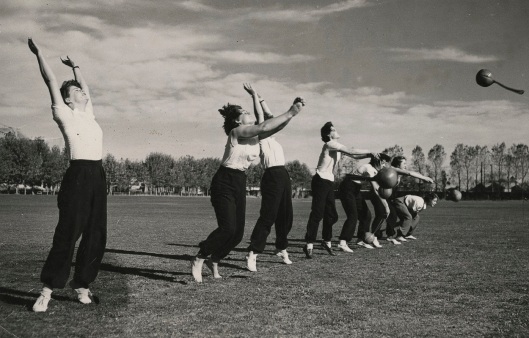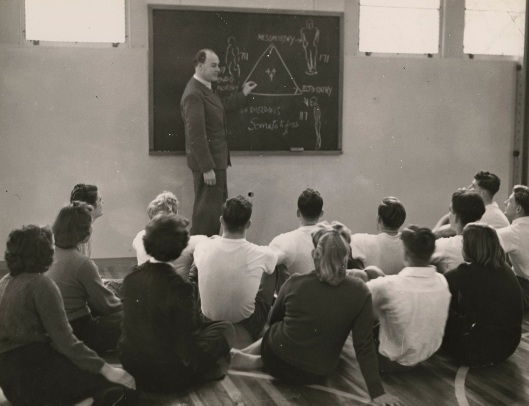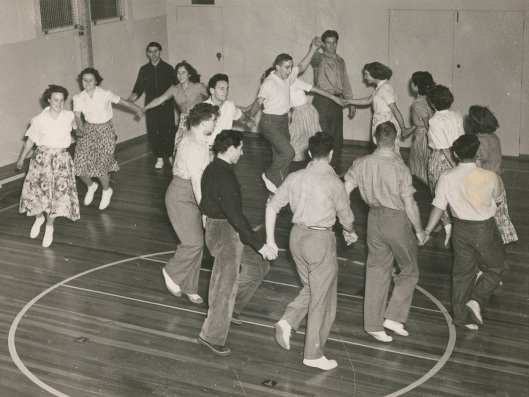Tags

Physical education students practising sling ball, year unknown. Photograph courtesy of the Hocken Collections, P.A. Smithells papers, MS-1001/222, S14-562c.
Much like the Department of Geography, the School of Physical Education was created in the 1940s to meet the demand for well-educated teachers. Early twentieth century educational authorities promoted physical training in schools, believing that healthy bodies created healthy minds. Compulsory physical education would, they suggested, prepare children to become better citizens. It wasn’t only educators that saw its value, though. Charles Hercus, who was Dean of the Otago Medical School and Professor of Public Health, was an early advocate of university education in physical education, seeing it as an important aspect of promoting the good health of the nation. In the late 1930s, he and the University of Otago authorities began the process of getting approval from the University of New Zealand for a degree in physical education, but the war held matters up. Auckland, too, liked the idea of beginning a diploma in physical education.
Matters became more urgent after the introduction of a new secondary school curriculum in 1946 – this made phys ed a compulsory subject for all secondary pupils. Earlier plans for a degree were put aside, and instead Otago obtained approval to offer a three-year diploma in physical education. This would give more flexibility and freedom to the university in moulding the course, and hopefully it would soon become well-accepted, just like the Associateship of the Otago School of Mines, which had a very good international reputation.
In 1947 Otago appointed the remarkable Philip Smithells as first director of the School of Physical Education, along with two other staff, Peter Robertson and Emmy Bellwood. Smithells – commonly known as PAS (from his initials) – was a Cambridge graduate who migrated to New Zealand in 1939 to become the national Department of Education’s Superintendent of Physical Education. He used his considerable expertise and skills to establish a respected course at the University of Otago, remaining director of the programme until his retirement in 1974.

Philip Smithells, affectionately known as PAS, teaching in the School of Physical Education, year unknown. Photograph courtesy of the Hocken Collections, P.A. Smithells papers, MS-1001/217, S14-562a.
Otago’s first class of 30 physical education students – known as the “guinea pigs” – began their course in 1948. Some of their courses were taken in other university departments: chemistry, physics, anatomy, physiology, education, and food values (in home science). But the school itself taught a wide range of subjects, including both practical and theoretical studies: physical education, pedagogy, gymnastics, games, athletics, aquatics, recreation, dance and health education. Classes were based at the old Training College building at 655 Cumberland Street and its gym nextdoor – these buildings are still part of the much expanded school today. Student numbers grew slowly, first exceeding 100 in total in 1961. From the early 1950s, outdoor recreation was taught at the Trotter’s Gorge Hut.
Most early students went on to careers as teachers. In 1967 Smithells, looking back at the school’s first twenty years, noted that 400 people had gained Diplomas in Physical Education, with 90% starting their professional lives as secondary school teachers. The generous bursaries and studentships offered to people training as teachers in that period were largely responsible for this. The wider range of careers open to today’s graduates is reflected in the school’s current name – the School of Physical Education, Sport and Exercise Sciences. But some early students did branch out from teaching: Smithells reported that former Otago students worked in child welfare institutions, mental hospitals and teachers’ colleges, including some now in senior management positions. A large number of women graduates who had married “work in their local communities in corrective work, work with older women and in modern dance.” Other early graduates had gone on to further education, with 30 obtaining masters degrees (and another 12 in progress); 7 had completed doctorates in the USA and Canada with 8 others in progress. Though there were, as yet, no postgraduate physical education courses at Otago, some staff and students had carried out research activities, assisted by “a well equipped exercise physiology laboratory, a partially equipped biomechanics laboratory, and a library in which both the book and serial collection is superior to any in the Southern Hemisphere.” A clinic offering individual physical education to children referred by their doctors provided important experience for students, as well as a useful service to the community; by 1967 it had treated about 500 children with special needs relating to “skill, courage, tenseness, motor control or perception.”

The School of Physical Education’s first class – the “guinea pigs” – practising a Kentucky running set, 1948. Photograph courtesy of the Hocken Collections, P.A. Smithells papers, MS-1001/222, S14-562b.
There is lots of interesting material about the early years of physical education at Otago, and further afield, in the papers of Philip Smithells, held at the Hocken Collections. These include many wonderful photographs, like the ones reproduced here – there are some particularly good photographs of modern dance and gymnastics. It seems we can hold Smithells partly responsible, too, for all those folk dancing classes at school! Do you have any memories to share of the early years of the School of Physical Education? And can you identify any of the students in the photographs, or help date them?

Hi Ali, I agree – I remember folk dancing at Tahuna Intermediate in the 1980s – until you mentioned in your blog, didn’t even click that the PE School would have a part to play in that “punishment”! 🙂
Folk dancing – turning us into better citizens! To be fair, I think the Colleges of Education also promoted folk dancing, so we can’t only blame the PE School.
Pingback: A sporting university | University of Otago 1869-2019
Pingback: Photo mysteries | University of Otago 1869-2019
Too late now, but I wonder if your full text acknowledges the third year Training College specialist year in Physical Education introduced by Renfrew White in 1928? My mother Molly Reid was one of the first year intake and appears in several illustrations for White’s book The Growing Body: its Nature, Needs and Training. A later director was Roydhouse.
Do you know that Philip Smithells was, as well as a great PE teacher, a splendid speaker of verse. Wordsworth was a specialty. Rodney Kennedy as organiser and my father Bert Dreaver as local liaison brought him to Balclutha in 1953 or 1954 and at a recital in the Drama Club room on Clyde Street I found his voice and delivery gripping. One of those growing points in late adolescence.
Thanks Anthony. Unfortunately there wasn’t space in the book to go into much detail about the Training College before it merged much later with the University, so I haven’t included any details of that course. That’s interesting about Smithells as a speaker! University Extension, including its drama programme, was so important in the university’s influence through the region.